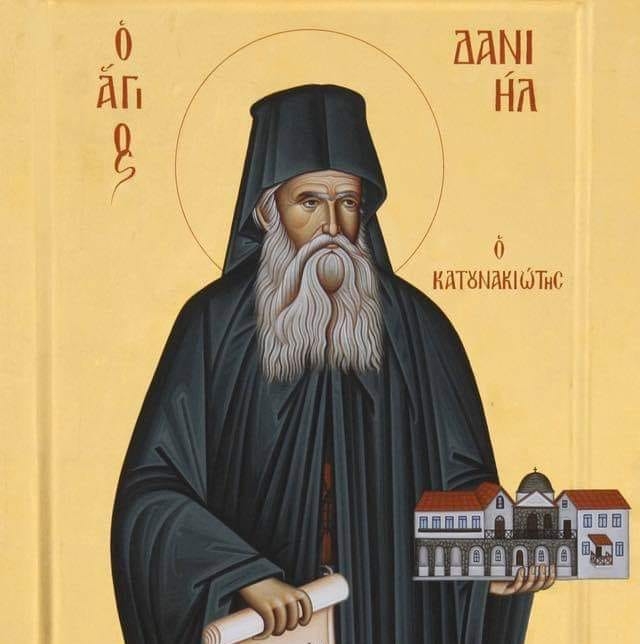
St Daniel of Katounakia was born in 1846 in Smyrna. Demetrios (as he was known in the world) studied at the renowned Orthodox Evangelical School of Smyrna, where he always excelled. The school lessons, however, were not able to satisfy all his longings or occupy all his care. His great love lay elsewhere: the sacred books, Holy Scripture and the Holy Fathers, which he studied unceasingly. The ascetic writers who dealt with the heights of spiritual life attracted him strongly. And something incredible happened – the Philokalia, which others of his age did not even know existed, he succeeded in learning by heart. He was enraptured by the angelic life of monks, and he thought of how he could abandon the world as quickly as possible.
In 1865, with the blessing of his spiritual father, at the age of 19, he set out to visit the holy places of pilgrimage and monasteries with virtuous monks in the Peloponnese and the Aegean islands. On the island of Paros, he met St Arsenios of Paros who blessed young Demetrios to go to St Panteleimon Monastery at Mt. Athos.
At St Panteleimon Monastery, he was tonsured a monk with the name of Daniel. Fr Daniel won over the whole Monastery by his obedience, nobility, and kindness and it was here that he first learned the blessed art of iconography for which later he became instrumental in bringing back the traditional Byzantine style. He was also recognised for his administration skills and was made secretary of the Monastery which comprised of 250 Greek and Russian monks. Soon after nationalistic differences arose between monks which forced Fr Daniel into exile, something that saddened him a lot. After six months in Halkidiki, he lived for five years in Vatopaidi Monastery (1874 -1879) where he was healed of a severe illness by Panagia. He was recognised for his humility and informed that the fathers were resolved to make him the representative of Vatopedi Monastery. Fr Daniel, however, would not exchange silence for any rank and forsook that Monastery and ran like a deer to the wilderness, to Katounakia.

Three and a half years later in 1880 he received his first disciples. Like bees searching for nectar-laden flowers, many souls gradually began to come to Elder Daniel when they discovered this spiritual flower blooming on the arid hillside. Through the sweat and toil of the brethren, a two-storied hermitage was erected, with cells, a reception room, an icon-painting room and a beautiful church.
St. Nektarios, being the slandered scapegoat of the ecclesiastical leadership of his time, found relief in the friendship of Elder Daniel. The Elder in turn received much support from the Saint in the construction of his hermitage and considered him a “builder and father and abbot of the holy community.” In his turn, the Hierarch was also helped by the Elder, writing an Epistle on Monastic Forms’ for his monastery in Aegina.
St Daniel spent fifty years creating a spiritual refuge on the dry stones of Katounakia, in day-by-day struggle for personal sanctification. During September in 1929, he took to his bed with a bad cold. He was given Holy Communion and with tears in his eyes and a trembling voice he gave to all his disciples who gathered around his pillow his final counsels and blessings. In the morning the Divine Liturgy was served in the hermitage. Two or three hours passed by. His face shone, and he smiled with delight at some sacred rapture. After Holy Unction, he passed away. How happy he appeared when he died on the feast of his Great Protectress, the All-hymned Mother of the Lord! On the 8th of September, the day of the Nativity of the Theotokos, at the age of 83, Elder Daniel’s soul flew to the heavenly tabernacles like a ‘bird of the desert’.
He was officially canonised a saint earlier in 2019 by the Ecumenical Patriarchate. His hermitage requested his feast day be celebrated the day before the feast, September 7 .





